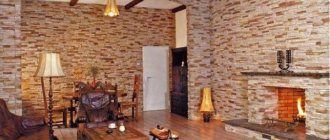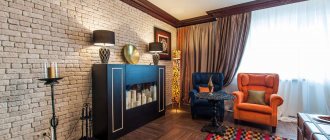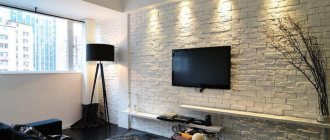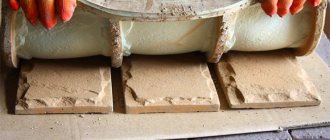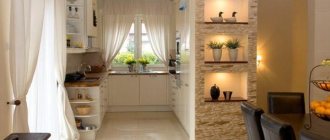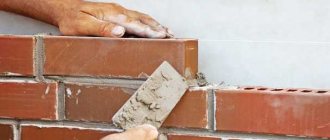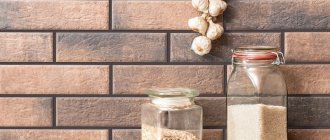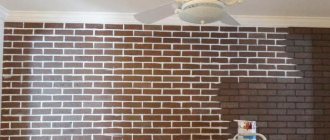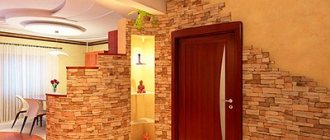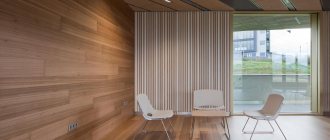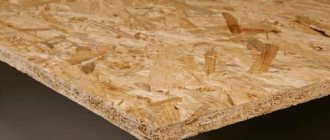Technology and nuances of laying decorative bricks on the wall
For several years now, decorative stone, namely brick, has been used in the interiors of apartments and country houses for wall cladding.
This material is sold at any hardware store. Customers have access to tiles of any color and size, which allows them to decorate the walls in the room. The main advantage is that the material can adhere to any wall made of any material, and the result will be similar to real brick.
The artificial material contains perlite, sand and expanded clay, although there are other types. Before you start decorating the walls in your house, you need to know what to glue gypsum bricks to and how to glue decorative bricks correctly.
Useful tips
Decorative stone looks good without any tricks. However, there are several secrets on how to give the final finish a designer look:
- The tiled surface looks harmonious if the sequence of laid elements of different shades and sizes is chosen correctly. When using slabs of the same size, it is necessary to accurately maintain the evenness of the lines diagonally, vertically and horizontally.
- Trimming the corners of individual fragments will give maximum attractiveness to the finish.
- The seams must be sealed with extreme care and a special bag for filling voids or a syringe gun must be used for this. The fact is that the solution that gets on the front surface of artificial decorative slabs is extremely difficult to remove.
Installation of artificial stone is simple and does not require significant costs, but work at all stages should be done as carefully as possible. In addition, you need to pay close attention to the compatibility of color shades and sizes, only in this case the finish will be pleasing to the eye.
Features of the material
Decorative masonry material is in great demand, because it has many advantages over natural brick. Artificial bricks are created from different materials, which are presented in the table:
To decorate the walls inside, it is recommended to choose the best option - gypsum brick. It will be cheaper than clinker and even more so than porcelain stoneware. Gypsum is stronger than other polymeric materials and is natural. Gypsum tiles are easy to make with your own hands by mixing water, gypsum and PVA glue. After pouring into the mold, the facing material should dry and it can be used for work.
Types of materials
In the modern construction market you can find a wide variety of decorative finishing materials. Elements that imitate brick or stone are in great demand. They can be made from different materials, the most popular products are:
Clinker.
A very durable and wear-resistant material, can be of completely different colors, used for any type of surface both outside and inside buildings. Gypsum. Quite fragile, but lightweight material, used mainly for interior work. Initially white, it can be painted both in a liquid state and after the element has been manufactured or installed. Polyurethane.
A very lightweight material widely used in interior work, mostly white, but may contain pigments. Foam plastic. Lightweight and fragile material, used for interior decoration. White.
For interior decoration work, the best option would be to lay brick-like tiles made from gypsum. It costs less than clinker, but is much stronger than its polymer counterparts and looks more natural.
Varieties of finishing materials for interior and exterior work
You can make decorative gypsum tiles yourself.
To do this, you need to mix water, gypsum powder and a plasticizer in the form of PVA glue. Pour the mixture into the prepared form and wait until it dries. You can add pigment to color the mass or apply paint to the bottom of the mold before pouring.
Tools and material calculations
Before gluing gypsum bricks to walls, you need to prepare tools and calculate the amount of material. To calculate, it is necessary to measure the length and height of the walls on which the installation will take place and multiply the resulting values. Door and window openings are removed from the resulting number in order to reduce costs. After calculation, about 10% is added to the total value for the reserve. Knowing how much material is needed, it is necessary to take into account that it is flat and angular, which is used at the corner of the room.
Tools for laying decorative stone
To work you will need:
You may need a hand tool in the form of a saw for cutting bricks. The adhesive composition is sold differently, depending on where the brick walls are being finished: inside, outside. The glue can be dry or liquid, in the form of a paste. Additionally, crosses are purchased so that the seam is even everywhere.
Laying decorative bricks with your own hands (video)
Area of application of the material
The decorative material, unlike its natural counterpart, weighs significantly less and allows it to be used on any surface. The stone is suitable as a wall covering for residential and non-residential premises.
Stone blanks are used for finishing building facades, interior decoration, decorating columns, and individual parts of the interior. Stone cladding of fireplaces is popular, but the material must not come into contact with the heating parts of the heating structure.
The combination of stone with treatment with hydrophobic agents allows for high-quality coating of swimming pools, saunas or baths.
The maximum level of resemblance to natural minerals is achieved through the production of additional elements by manufacturers for framing window openings and corners.
Not used as a floor covering.
